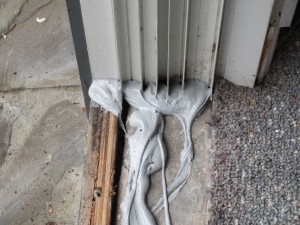
The simple act of keeping a sliding door sealed will ensure that it glides smoothly for a long time.
Sliders that have been exposed to water can be tough to open and close. If water has worked its way into the door frame, the rollers and bottom track will deteriorate over time.
Sliding doors that lead outside, such a patio sliders, are highly susceptible to this type of moisture. But even interior sliders located in humid areas such as bathrooms can be damaged in this way.
So keep an eye on the condition of the seal around all doors in the house. If it seems to be missing or looks cracked, keep moisture out by resealing.
If you are a do-it-yourselfer, do this by checking out the existing caulk line – whoever initially installed the sliding door likely sealed it, so the old caulk is easy to spot – and remove damaged or cracked caulk with a utility knife or screwdriver.
It may be easier to provide an overall watertight seal by removing all the caulk surrounding the door. Seal the door surround with a caulking gun. If you’re unfamiliar with how a caulking gun works, a hardware or home improvement store employee can explain how to use it.
Sealing your sliding doors guards against moisture and ensures they will glide smoothly, but there is an added benefit: A tight seal helps regulate indoor temperatures.
A well-insulated sliding door will prevent cold air from seeping into your home or office in the winter and keep warm air outside in the summer, when the AC is on.
If sealing your sliding door seems to be too big a job for you, hire a door contractor to do it for you. Give A-1 On Track a call today at 408-866-0267. We’ll reseal and also make other repairs to your sliding doors.
